Foreworld
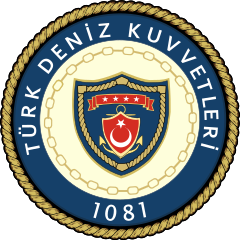 This post is about one of the most important regional fleets of the cold war, when Turkey had a crucial role within NATO at the gates of Asia and USSR. The post also looks on the current Navy, as 2020 – Because newsreels commands it: Under Tayyip Erdogan since 2014, Turkey’s path mirroring Russia as the growing weight of its international policy is underlined by and ambitious naval program to match it. So that’s makes the right time to study this fleet, a logical step after China, Iran or North Korea.
This post is about one of the most important regional fleets of the cold war, when Turkey had a crucial role within NATO at the gates of Asia and USSR. The post also looks on the current Navy, as 2020 – Because newsreels commands it: Under Tayyip Erdogan since 2014, Turkey’s path mirroring Russia as the growing weight of its international policy is underlined by and ambitious naval program to match it. So that’s makes the right time to study this fleet, a logical step after China, Iran or North Korea.
A collision course with Turkey is unlikely today, notably due to the position of Turkey within NATO, and therefore support of the US and most NATO members as the linchpin of the eastern defense of the whole alliance, and is still massively equipped with western hardware in 2020 (but it’s changing fast).
Actual strength
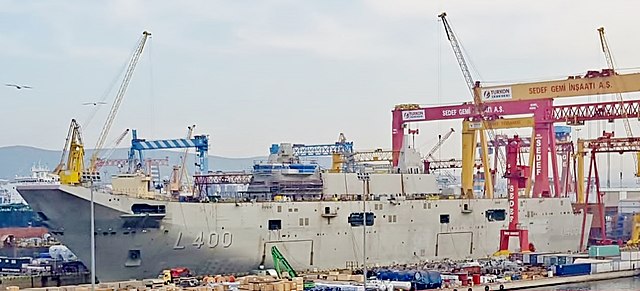
Turkey is now developing its own main battle tank, the Altay and a wide range of AFVs, widely exported, and the Turkish Aerospace Industries (TAI) are developing a 4th generation stealth superiority fighter. On the naval side, the actual Turkish Navy is not of the size of its formidable ancestor, the 1500s Ottoman Navy which made the Mediterranean its own lake, but the first “aircraft carrier”, LHD Anadolu, has been launched and is undergoing completion, as well as brand new large missile destroyers.
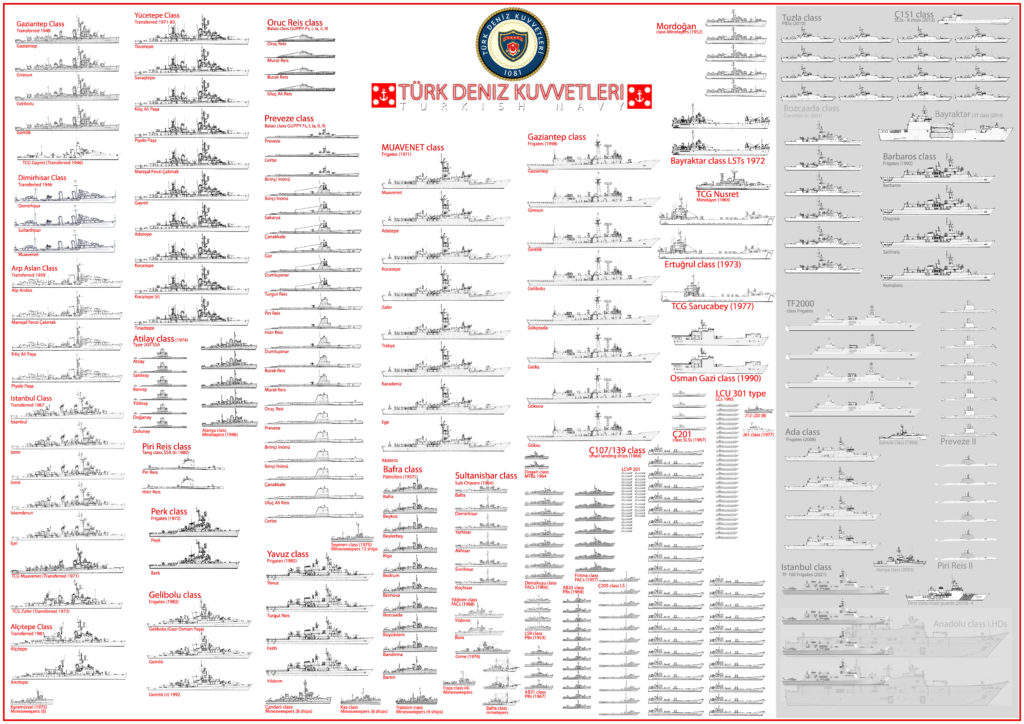
Turkish Navy in the cold war poster. Actually, it’s a compromise, as minesweepers and patrol boats, coast guards, are not represented to the full, as the space was lacking. On the right side however, a good overview of the Turkish Navy since 1990, including classes in building.
In short today, the Turkish Navy boasts 48,600 personnel, 51 naval aircraft, 16 frigates, 10 corvettes, 19 FACs, 12 (conventional) attack submarines, 16 PBs, 11 mine warfare vessels (MWF), 33 amphibious ships, and round 50 misc. ships and auxiliaries. Its current projects includes two LHDs (Anadolu, planned completion 2021, TCG Trakya) 12 MILGEM project corvettes and frigates (first, F-511 TCG Heybeliada, comm. 2011), four Istanbul class (I class) frigates, close to missile destroyers, plan for four TF-2000 AA “frigates” (also called destroyers), six Type 214 AIP submarines, new LST and LCT classes (2+8 approved 2006), New AOR Ship, Submarine Rescue Mother Ship, Rescue & Towing Ship (2), new FACs, Air-cushioned landing craft, modernizations for the 2020s of older classes, and the Distant Horizon Project.
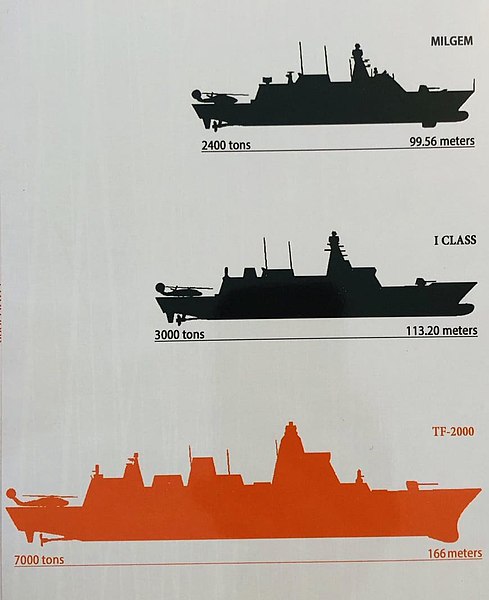
MILGEM project’s ships; showing the planned classes in development or construction. The TF-2000 obviously are destroyer-size and had the same capabilities, at 7,000 tonnes and $3 billion unitary cost, with seven planned. They are typical of the new generation of 2000 large versatile frigates built in the Mediterranean (like the FREMM), destroyers in all but nomenclature. True destroyers are now -according to current constructions like the Chinese type 055- 10,000 to 13,000 tonnes and more.
The latter, according to the official documentation is displaying objectives for the Turkish Naval Forces of a “Medium Regional Power Projection Capability”, which sounds reasonable, and in accordance to the absence of a true aircraft carrier, or “true” missile destroyers. The reinforcement of capabilities for assault on the Mediterranean however, is clear, and frigates have the range to escort amphibious these task forces. Naval deterrence is relying on a serie of trusted, recent and silent German-built attack submarines, ans land missiles. As yesterday, Canakkale, the Dardanelles, are a natural, formidable choking point between the black sea and the historic heart of the Turkish navy.
Early beginnings: The Turkish Navy in 1945

Turkey’s flagship from 1914 to 1950, TCG Yavuz.
The Navy of the founding father of the Nation, Kemal Atatürk, was born in the 1920s and was reinforced with many constructions (chiefly from UK and Italy), and the WW2 Turkish Navy was a potent green water navy that never had another task but to protect Turkish waters. It did so with success, Turkey remaining staunchly neutral, with the most exotic and unusual flagship of that time, a WW1 battlecruiser, Yavuz. The country tried to maintain equal distance between both the Axis and the Allies until February 1945, when it entered the war on the allied side, which seemed obvious. However its proximity with the turbulent giant in the north, USSR, and the bullying attitude of Stalin towards Turkey, the inheritor of Imperial Russia’s oldest foe, with Sweden, made only matter worse.
It should be noted Turkey claims to have a oldest military navy in the world, founded in 1081. The modern Navy was created by Ataturk as of July 10, 1920, called the Directorate of Naval Affairs. In 1949 it was reborn (July, 1st) as the Turkish Naval Forces Command.
Turkey emerged from WW2 with its fleet intact, unscaved:
-A capital ship: Yavuz (now close to reserve 1948 Izmit, decomm. 1971)
-8 destroyers: four 1931 Italian-built Kocatepe-Tinaztepe class, 4 ex-British ones transferred in 1945 after Turkey entered side with the allies in February.
-10 submarines: Inönü class, Dumlumpinar, Sakarya, Gür, Ay class. 3 transferred, ex-S class British Burac Reis class.
-3 minelayers, 2 coastal minesweepers, 26 MTBs.
These ships were gradually decommissioned, from 1955-57 to 1960 and 1965.
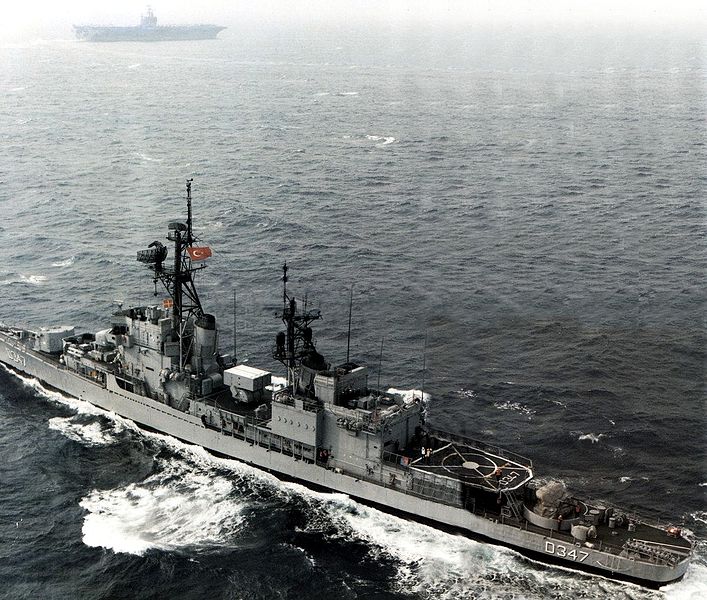
TCG Anitepe in 1988
At the same time, USSR was now at the gates of Turkey and Stalin’s ambitions met old Russian grievances about borders with the old enemy. The Soviet ambassador, backed by a military giant, asked repeatedly for borders revisions on the eastern Balkans part and Caucasus, and change de strait agreements to allow the Soviet fleet to transit freely from the black sea to the Mediterranean. After it was flatly refused, this scared the country enough that as situation became colder and degenerated between former allies, Turkey attempted a rapprochement with the west, and as soon as NATO was created in 1947, asked to join. However at first, like Greece, Turkey signed an aid treaty with USA. This guaranteed the country that any Soviet intervention on its border with trigger and intervention of the USA. Turkey effectively entered NATO after negotiations in 1952.
Turkey with NATO: cold war naval development
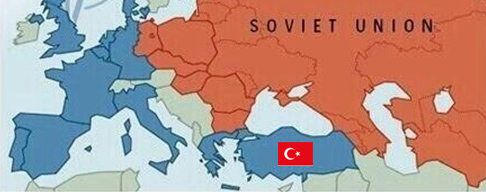
Turkey facing USSR on the map – 1990. Extract from Der Spiegel
The historic decree of the Higher Military Council (15 August 1949) led to the foundation of the modern Turkish Naval Forces Command or Deniz Kuvvetleri Komutanlığı from 1952, integrated into the organizational branches of the alliance.
Organization in 1961
By that time, four main subordinate commands were created: The Turkish Fleet (Gölcük), Northern Sea Area (Istanbul), Southern Sea Area (Izmir) and Naval Training Commands (Istanbul). From 1995, the latter has been renamed Turkish Naval Training and Education Command.
Gölcük is also the main naval base, yard and arsenal of the Turkish Fleet.
Fleet Command
-Surface Action Group Command, Gölcük Naval Base, Kocaeli
-Submarine Group Command
-Fast Patrol Boat Group Command, Istanbul
-Mine Warfare Group Command, Erdek Naval Base, Balıkesir
-Logistic Support Group Command, Gölcük Naval Base, Kocaeli
-Naval Aviation Group Command, Cengiz Topel Naval Air Station, Kocaeli
Northern Sea Area Command, Istanbul
-Istanbul Strait Command
-Çanakkale Strait Command
-Naval Hydrography and Oceanography Division Command
-Naval Museum Command, Istanbul
Southern Sea Area Command, İzmir
-Naval infantry Brigade Command, Foça
-Amphibious Group Command, Foça
-Naval infantry Battalion Command, İzmir
-Accompaniment and Patrol Boats Flotilla
-Aksaz Naval Base Command, Aksaz Naval Base, Marmaris
Naval Training and Education Command, Istanbul
-Naval Academy, Tuzla, Istanbul
-Naval High School, Heybeliada, Istanbul
-Karamürselbey Training Centre Command, Yalova
Marines and special divisions
-Amphibious Marine Infantry Brigade Command
-Underwater Offence Group Command
-Underwater Defence Group Command
The entry of both Greece and Turkey into NATO were a necessity on the strategic level to safeguard the Mediterranean against Soviet ambitions, but also contained problems for the future, due to the rocky nature of relations between the two new members. Both countries indeed claimed the control of the Aegean islands and Cyprus, while Turkey’s internal politics was unstable and after each coup, the central power tried to divert attention and focus on external issues, or wanted to display strength towards Greece.
Cyprus became independent in 1960 but situation degenerated, as the country was split in two, the western was Greek, with strong pressure in NATO and UN for Enosis (union), while Turkish forces occupied the eastern part. In 1964 it scaled up to open war, between two NATO members. Both landed troops, mobilized aviation and their fleet (see later) in 1964. Eventually, the UN sent blue helmets there to separate both camps and put a provisional end to the fight.
https://youtu.be/yB1xwOfHYsM
The war in Cyprus – Documentary
Meanwhile, Turkey considerably reinforced its fleet with the aid of the US. This was a leasing contract wit very generous terms, allowing the transfer of recent ships, just like Greece and other NATO members. From 1949 and until 1982, Turkey obtained and armada of brand new destroyers: Four of the Gleaves class (Gaziantep) in 1950, four British M class (Arp Aslan) in 1959, five of the Fletcher type (Icel class) in 1969, two Allen M Sumner in 1971 (Muavenet class), and moreover ten modern Gearing FRAM in 1971-1982. This would add some weight in the conflict. The last two acquired in 1981-82 were the Anitepe class, ex Carpenter (an ASW specialist Gearing FRAM I subclass). Added to the previous ships, in 1981, Turkey had 19 destroyers. The earliest ones were discarded in the 1970s. In the 1960s Turkey also started to acquire amphibious forces: mix of ex-British ww2 LCT(4) 700 tonnes ships, arrived in 1967 and modernized, four LCU-501 class of the same ear, thirteen 1960s LCM(8) types. Others were built locally (see later).
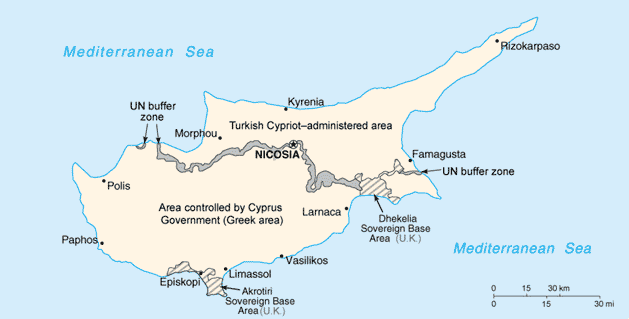
In 1971 for the first time, Turkish yards delivered warships: Gölcük N Yd which launched D358 and 359, the ASW Berk and Peyk. Both were built on US plans, in fact they were close copies of the Claud Jones class. At the same time eleven Balao class submarines were transferred, followed in 1972-73 by ten more of the Balao/GUPPY IA, IIA and IIIA types to replace the previous 1950s Balao types.
Amphibious ships were also built locally, LCU types in 1965-66 and LCM(8) in 1984-93 and EDIC class ships (French design) in 1966-80. Large landings and assault ships were also acquired in the 1970s: Two LST 511 class in 1972, two more modern Terrebonne Parish class ships in 1973-74. More importantly in 1977, Taskizak NYd in Istanbul delivered a large assault ship, the 1600 tonnes LST Cakabey. She was followed by two more in 1981 and 1984.
In 1975 the situation with Cyprus bounced again, Turkey, with it’s newly acquired amphibious ships, mounted an attack on Cyprus. The only naval loss was the escorting destroyer TGC Kocatepe, sunk by error by Turkish aviation, it was confounded by a Greek Gearing FRAM destroyer. This move triggered the Congress to impose an embargo on Turkey, lifted in 1980. From then on the question of Cyprus was left to rest but old enmities are still there.
Late cold war Turkish programs
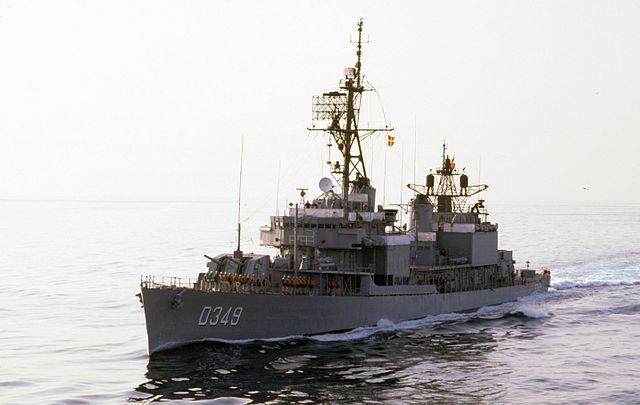
TCG Kilic Ali Pasa, D349 (cc)
Turkey made two acquisition of non-GUPPY types submarines in 1980 with a transfer initially planned for Iran of two Tang class attack submarines. But in the 1970s, as well as many GUPPY types were acquired, Turkey restarted its long relation with Germany. Indeed in the 1980s the EU and Turkey started a rapprochement and negotiations for a possible future entry, and this was reflected on the naval side. Distancing from the US (there was no longer a preferential aid, which became obsolete by 1990), Turkey started to close its bond with the “old ally”, West Germany then. This was reflected on the economical side with mass immigration to Germany and a very important Turkish community there, and through orders:
-In 1971, a contract was signed for the delivery of Type 209 submarines, six boats of the Atilay class.
-In 1982, Turkey acquired two ex-Köln class frigates (Gelibolu class)
-In 1981 and 1984, two tank landing ships were built locally at Taskizak NyD (Sarucabey class)
-In 1984, signed an important contract for the delivery of four MEKO type frigates, the Yavuz class.
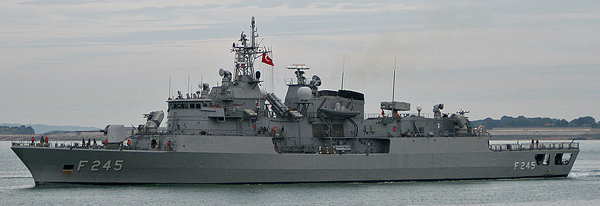
1990s Turkish naval programs
-This was followed in 1994 by four more MEKO 200 types, half built locally at Gölkük NyD.
-Long-forged links with the US however allowed the transfer of nine Knox class Frigates in 1993-94.
-Also in the 1990s, Turkey accepted delivery of four more Type 209/1400 submarines, modernized versions all built locally at Gölcük.
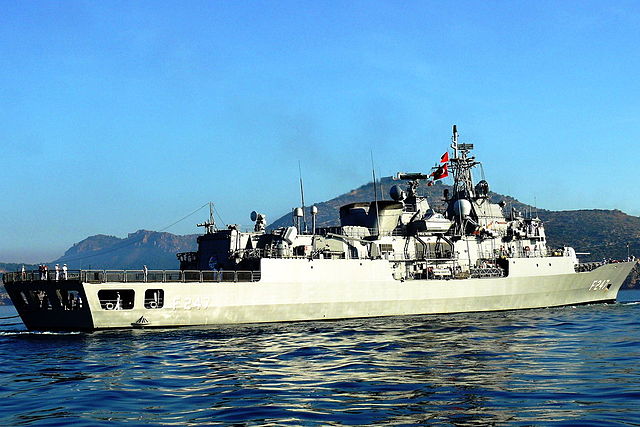
Strength in 2015-2020
In 2015, the Turkish fleet operated 16 frigates, 8 corvettes, 13 submarines, 23 missile boats, 28 patrol boats, 32 mine countermeasures vessels, 29 landing ships, and auxiliaries, ranging from 259,000 tonnes to 300,000 with the last LHD and constructions. In addition there is a fleet air arm which possesses eight Italian-built transport ATR 72 MPA and two of ASW patrol, modernized in Turkey, five CASA CN-235 of electronic warfare, modernized by Thales, seven SOCATA TB trainers, 30 Sikorsky S-70B-28 Seahawk and twelve Agusta-Bell AB-212 ASW of SAR and ASW warfare.
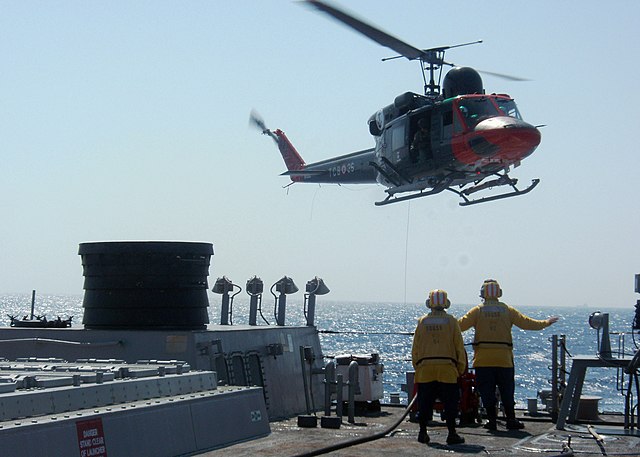
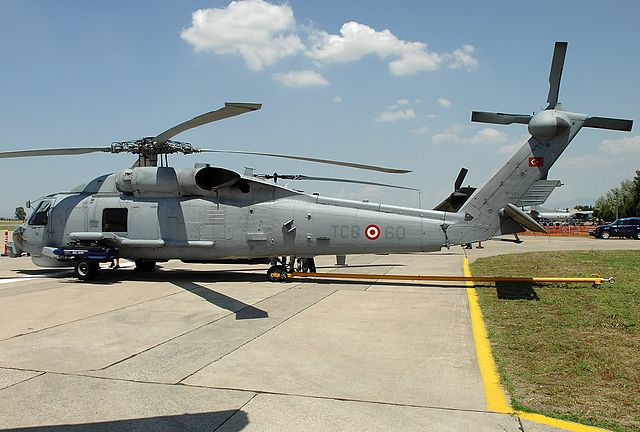
Turkish Sikorsky S-70B-2 Seahawk, used on a number of ships and naval bases, used for ASW warfare primarily, spec ops and SAR secondary.
Naval Programmes 2020-2030
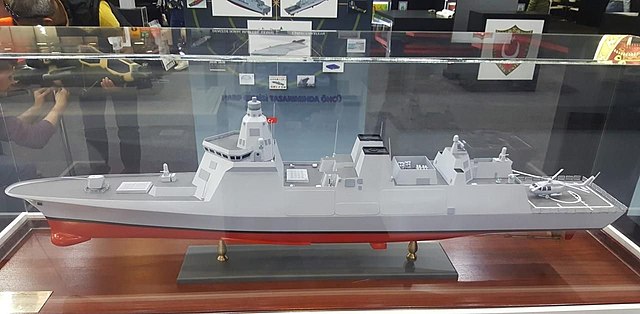
-Construction of twelve MILGEM project warships:
- 4 Ada class corvettes*
- 4 TF-100 (Istanbul) class frigates**
- 4 TF-2000 class air-defence frigates***
*F-511 TCG Heybeliada, was commissioned in 2011, F-512 TCG Büyükada in 2013, F-513 TCG Burgazada in November 2018.
**These 1st class frigates built in Istanbul are the latest started, with stealth capabilities. TCG İstanbul (F-515) was laid down in 2017, expected launch fall 2020 (COVID disruptions and budgetary issues). They boast 16 × Harpoon/Atmaca (local version) and 16 Mk.41 VLS for ESSM.
***The TF-2000 are easily the largest of the MILGEM programme: Although called Frigates they are the equivalent of the latest large European frigates in tonnage and capabilities at 7500+ tonnes.
Approved on 5 December 2007 by the Defence Industry Executive Committee for 4 fixed and 2 optional and eight fixed by January 2013. Currently planned to carry the Tübitak G-40 SAM, Gezgin Land Attack Missile and Atmaca Anti-Ship Missile, in silos.
-Six Type 214 AIP submarines: Signed 2 July 2009, exec. 22 June 2011.
-TCG Anatolia (L-400) amphibious assault ship (LHD)/aircraft carrier to enter service in 2021, sister ship TCG Trakya laid down.
-New LST class (unnamed, approved 12 December 2006, LCM-1E type, 8+).
-New Auxiliary Oil Replenishment (AOR) Ship, unnamed, a Submarine Rescue Mother Ship, 2 rescue & Towing Ship, the Type Su Altı Taarruz Boat Project (Fast Intervention Boat), and Air-cushioned landing craft Project.
The Turkish Navy is a member of AFSOUTH, BLACKSEAFOR, EUBG, EUROCORPS, EUROGENDFOR, EUROMARFOR, LANDCOM, LANDSOUTHEAST, SHAPE, SNMG2, SNMCMG2 and the Black Sea Naval Force in addition to NATO
International deployments comprised ALTHEA, CTPF, ISAF, KFOR, UNAMA, UNIFL, UNMIK, Operation Ocean Shield, and Afrika Kartali
Read More:
https://en.rayhaber.com/2020/05/istif-sinifi-firkateynlerin-ilki-tcg-istanbul-2020-sonunda-denize-inecek/
https://www.dzkk.tsk.tr/data/icerik/392/Turkish%20Naval%20Forces%20Strategy.pdf
https://turkishnavy.net/
https://www.dzkk.tsk.tr/
https://www.trtworld.com/turkey/turkish-naval-strength-in-eastern-mediterranean-shifts-balance-of-power-37730
https://www.navalnews.com/tag/turkish-navy/
https://ahvalnews.com/turkish-military/how-capable-turkish-navy-projecting-power
https://www.hurriyetdailynews.com/search/turkish%20navy
https://www.navypedia.org/ships/turkey/tu_index.htm
http://www.denizmuzeleri.tsk.tr/
https://web.archive.org/web/20101225070935/http://ijnhonline.org/volume1_number1_Apr02/article_guvenc_turkey_navy.doc.htm
https://www.ssb.gov.tr/Default.aspx?LangID=1
https://www.maritime-executive.com/article/turkish-navy-escorts-seismic-ship-into-greece-s-continental-shelf-zone
https://www.navyrecognition.com/index.php/component/search/?searchword=turkish&searchphrase=all&Itemid=2178
https://en.wikipedia.org/wiki/Turkish_Naval_Forces
https://en.wikipedia.org/wiki/List_of_active_ships_of_the_Turkish_Naval_Forces
https://en.wikipedia.org/wiki/List_of_major_surface_ships_of_the_Turkish_Navy
https://en.wikipedia.org/wiki/List_of_submarines_of_the_Turkish_Navy
https://en.wikipedia.org/wiki/Lists_of_ships_of_the_Turkish_Navy
Cold War Turkish Navy
Demirhissar/Gayret class destroyers (1945)
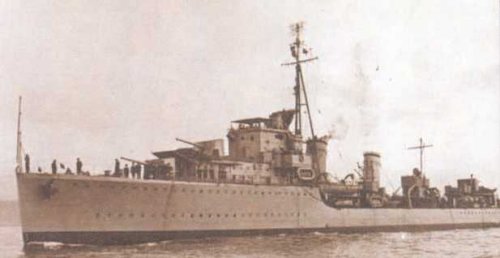
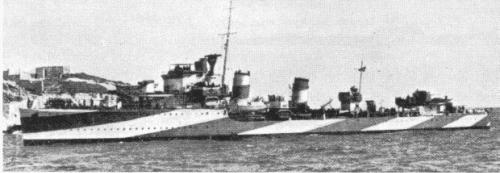
TGC Sultanhissar in 1946
Turkey ordered four destroyers in late 1938 to UK similar the the British “I” class with quadruple TT banks and simplified fire control system. However these destroyers in construction at Vickers-Armstrong were requisitioned in 1939 and completed in 1942 for the Royal Navy as HLS Inconstant (Muavenet) and HMS Ithuriel (Gayret). In 1945 the first was was returned to Turkey while HMS Ithuriel, badly damaged by the Luftwaffe in 28/11/1942 was never repaired and broken up. In 1946, HMS Oribi was transferred in her place. They had been preceded by Demirhissar and Sultanhissar, transferred in 1942 but still integrated to the Royal Navy structure and with a British crew, and in 1945 they were fully transferred, with well formed Turkish crews. They were armed by four 120mm/45 Mk lX** guns and 2 quadruple 40mm AA, but this was changed to two single 20mm/70 Oerlikon and six single – 40mm/60 Mk 3 Bofors in the 1950s. Their electroncs were also mdernized: Demirhisar and Sultanhisar had a type 271 and type 286M/P radars plus a type 124 sonar, while TGC Muavenet had a type 271 and type 291 radars and type 144 sonar.
The three first 1880 tonnes Gayret class (I class) were discarded in 1960 and the O-class Gayret in 1965.
Gaziantep class destroyers (1949)
TGC Gaziantep, Gelibolu, Gemlik, Giresun
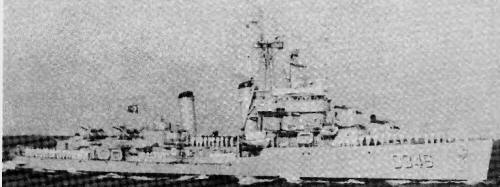
TGC Gelibolu in 1970.
Standard 1942 Gleaves class destroyers built at Federal, Kearney, transferred in two batches, April 1949 and 1950. They were unmodified although modernized in 1945 with radar. In 1957-58 the four ships returned to the USA for modernization: Fully enclosed bridge, tripod foremast X main gun turret replaced by four 3-in AA guns. They were discarded in 1973, 1976 and 1981. Pennants were D344 to D347.
Specifications: As WW2 Gleaves class but 4x 5-in (127 mm) and 4x 3-in/80 AA.
Arp Aslan class destroyers (1959)
TGC Arp Aslan, Kilic Ali Pasha, Maresal Carmak, Piyale Pasha
Ex-Scotts, Vickers and Stephen built ‘M’ class WW2 British destroyers, ex- HS Marne, Matchless, Meteor and Milne. They were all acquired on 26/06/1959, refitted before transfer: The aft TT bank was removed as well as AA guns, a new deckhouse was built and modern AA/ASW armament installed (see notes). They were discarded in 1972-75.
Specifications: As M class, except 6x 40 mm AA (1×2, 4×1), 1×3 Squid ASW Mortar, 1×4 21-in TT. No photos found (yet).
Istanbul class destroyers (1969)
TGC Iskenderun, Icel, Istanbul, Izmir, Ismit
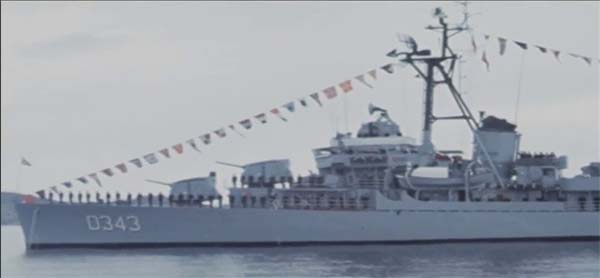
TCG Icel (D 344) – Youtube footage
Standard Fletcher class destroyers, acquired in 1967-69 as they were to be discarded. Not modernized much in US service to the exception of TGC Icel that had a rebuilt bridge and served as a training ship in Gölcük. They were discarded in 1980-81 (Izmit, Icel, Iskanderun) and 1987 (Istanbul, Izmir). Pennants were D343-344.
Muavenet class destroyers (1971)
TGC Muavenet, Zafer
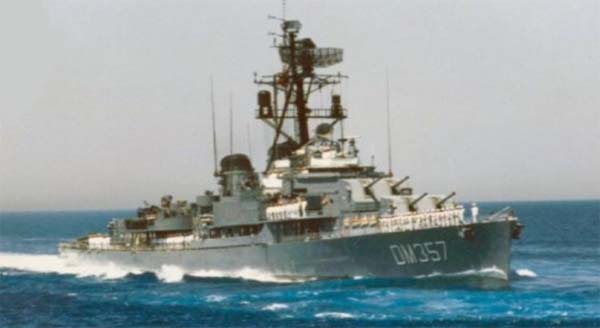
Ex Allen M Sumner ships, modernized with without ASW equipment. They received new radars and armament in 1981-83: SPS-40 and a twin 76 mm automatic cannon. Mines rails were kept, able to deploy 80 mines. TGC Muavenet was badly damaged on 2 october 1992 during exercises with NATO by a sea sparrow that was launched from USS Saratoga by error. She was not repaired but discarded instead in 1993 and her sister ship Zafer in 1994. The latter has a FRAM II modernization and was transferred in 1971 fitted wit two twin 40 mm bofors and a twin 35 mm Oerlikon in 1979.
Adatepe class destroyers (1971)
Adatepe, Maresal Cakmak, Gayret, Kocatepe, Tinaztepe, Savastepe, Kilic Ali Pasha, Pyiale Pasha, Yucetepe.
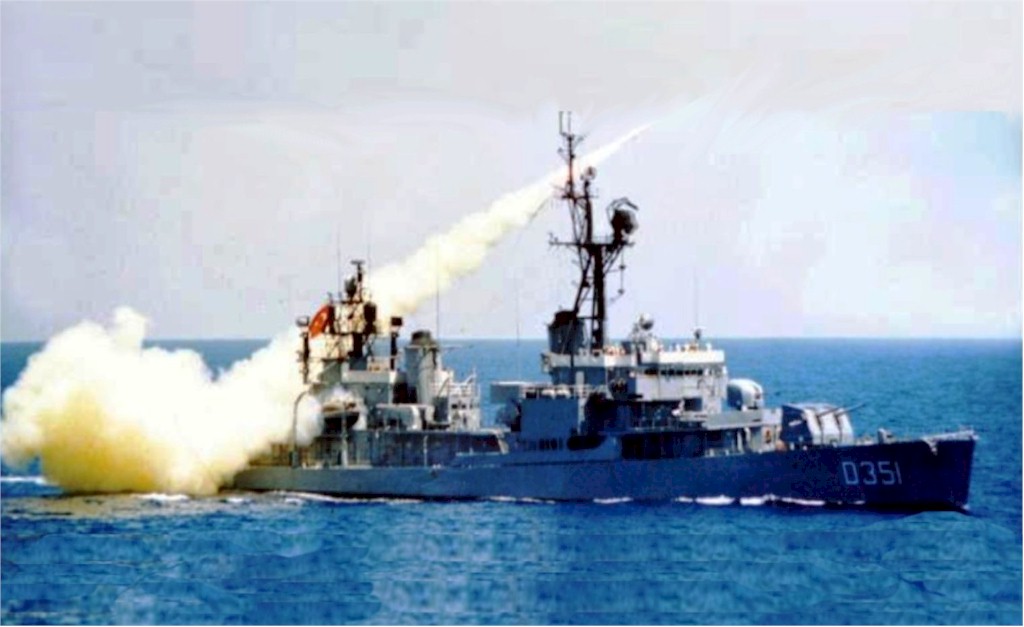
TGC Maresal-Fevzi-Cakmak in the 1980s, firing the ASROC.
This was a massive transfer of ten Gearing class destroyers, all modernized to the FRAM I and FRAM II standard. They were acquired gradually, from 1971 to 1982. There were two Kocatepe in fact. The first was sunk by error by Turkish Jets off Cyprus during the war on 22 july 1974. She has been mistaken by one of the many Greek gearing FRAM types also operating in these waters. Tgis forced the admiralty to take into service the ex-USS Norris, purchased for spares, pressed into service with the same name. Ex-USS meredith renamed Savastepe was also used for spares. The ex-Mac Kean was also damaged in a collision ans used for spares. This was the 11th Turkish Gearing class DD.
Cakmak, Gayret and Adatepe were FRAM I types, fitted with two 40 mm Bofors fitted on the helideck, and later twin 35 mm oelikon in 1980 plus two twin Bofors in 1979. ASW consisted in a single ASROC launcher and two triple 324 mm TTS, and DC rack. Tinaztepe was damaged in a collision in 1984 and never repaired, laid up. Others were discarded in 1993-94 but as of 1995, five were still extant.Kilic ali pasha, Piyale Pasha, Yucetepe were in leased and little modified. Cakmak and Gayret were upgraded with two quadruple Harpoon SSM placed on the helideck and others later, but the prospects of gving them Sea Sparrow SAMs was dropped in the 1990s.
In addition there were two more Gearing class ships: They were Carpenter class specialized ASW conversions, launched in 1948 after some modifications and useful in the cold war. Scheduled to be replaced by Frigates, they were transferred in 1981 and 1982 with an armament of a single forward twin 5-in turret, ASROC, two 324 mm ASW TTs, a twin 35 mm Oerlikon, a twin 76 mm DP, and still in service in the 2000s.
Berk class Frigates (1971)
TCG Berk, Peyk
conways profile
These first major warships built in Turkey, based in the USN Claud Jones class, but with a slightly different hull, and more powerful armament, different machinery and a single large funnel. There was an aft helicopter pad but no hangar. Both were built in Golcük NyD, laid down in 1967 and 1968, launched 1971-72 anc completed a year later. They were still listed active in the 2000s.
Specifications
Displacement: 1450/1950 tonnes
Dimensions: 95.2 x 12.1 x 5.7 m
Machinery: 1 shaft, 4 FIAT diesel 24,000 hp 25 knots range 10,000 nm
Armament: 2 twin 3-in/50 (76mm), 2×3 324 mm TTs ASW, 2 Hedgehog
Electronics: SPS-40, SPS-10, SPG-4, SQS-11
Crew: 175
Yavuz class Frigates (1985)
Yavuz, Turgut Reis, Fatih, Yilderim
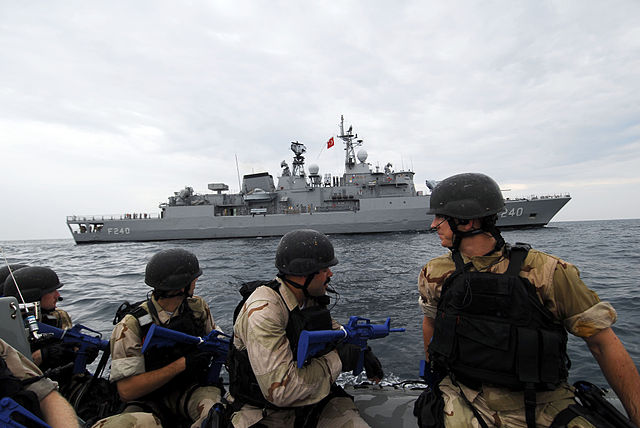
Four MEKO 200 Frigates (West Germany) were purchased in april 1983, with an agreement for a local production at Golcük was part of the deal, with technology transfers and assistance. The first, TCG Yavuz was built at Blohm & Voss Wilehlmshaven, delivered in 1987, TGC Turgut Reis in Howaldswerke Kiel, delivered in 1988 and the two others in Turkey, were launched in 1987 and 1988 and completed a year later. They were essentially the last cold war major warhips built in Turkey. This popular export type was also used by Portugal and Greece. The Turkish Navy customized them with 25 mm Sea Zenith CIWS and they carrie AB-212 Augusta helicopters armed with Sea Skua SSMs. But they are well armed, for the long range, with two sets of Harpoon missiles, a sea sparrow SAM, three quadruple CIWS, TTs, decoys and multitask helicopter. With their complete electronics suite they are quite capable ships, still in service today.
Specifications
Displacement: 2700/2990 tonnes
Dimensions: 110.5 x 13.25 x 3.94 m
Machinery: 2 shafts MTU TB93 diesels, 40,000 hp, 27 knots, range 4,000 nm
Armament: 1x 5-in (127mm), 3×4 25mm Oerlikon CIWS, 2×3 324 mm TTs ASW, 2×4 Harpoon SSM, Sea Sparrow SAM, 1 Helicopter
Electronics: TM-1126, ASW-6, HSA DA-08, WM-25, STIR-24, Sonar SQS 56, ECM Rapid/Ramses suite Mk86 SBROC decoy RL, SLQ-25 Nixie towed torpedo decoy
Crew: 180
Birinci Inonu class submarines (1948)
This new generation of submarines gradually replaced the Interwar models mostly coastal, Italian or German (Dutch/Spanish) ones. In all, eleven Balao class submersibles were acquired from 1948 to 1960. The class comprised the Birinci and Ikinci Inonu, Gur and Sakarya (1948), Canakkale, Dumlumpinar (1950), Cerbe, Preveze (1954), Turgut Reis (1958), Hizar Reis, Piri Reis (1960). Apart TCG Dumlumpina lost in 1954, they were discarded in 1973-77. No changes compared to the WW2 standard in 1948-1950, but from Canakkale, streamlining of the hull and fin started, and conversion to this standard went on until 1960 as “fleet snorkels”. Two more were purchased for spares in 1973.
On more called TCG Dumplumpinar was a GUPPY-IA transferred in 1972, damaged in a collision in 1976, beached, repaired and back in service until 1987.
Murat Reis class submarines (1970)
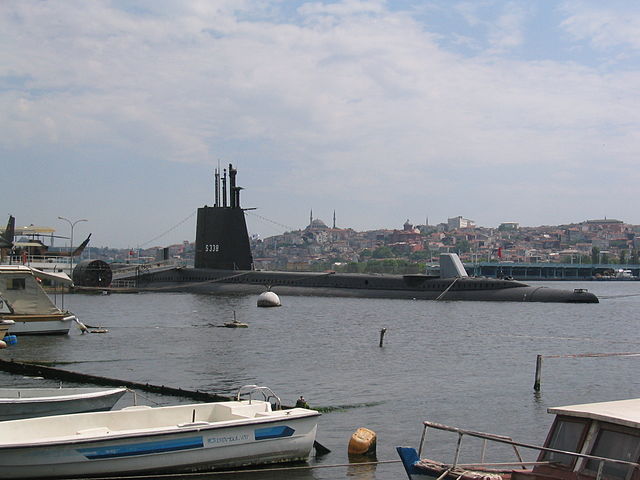
S338 as preserved
A batch of seven Balao GUPPY IIA were acquired in 1970-73, replacing the earlier Balao. The class comprised Burak and Murat Reis, Cerbe, Oruc Reis, Birinci Inonu, Preveze, Uluc Ali Reis. The Cerbe was a GUPPY-III and the only extant submarine of this type with the original stepped sail.
TCG Canakkale and and ikinci Inonu were acquired in November 1973, they had been converted as GUPPY III before transfer (1962), and two more were planned (Clamagore, Tiru) but blocked by the US Congress enforcing an arms embargo in 1975. Three stricken in 1987, the others in the 1990s.
Piri Reis class submarines (1980)
Piris Reis, Hizir Reis
These were the first modern attack submarines acquired by the Turkish Navy, ex-Tang class (Tang, Gudgeon), diesel-electric attack submarines initially planned for Iran, and following the revolution leased for 5 years to Turkey, then purchased in 1987. Both were decommissioned in 2004. Specs as the USN Tang class.
Atilay class submarines (1974)
Atilay, Saldiray, Batiray, Yildiray, Doganay, Dolunay
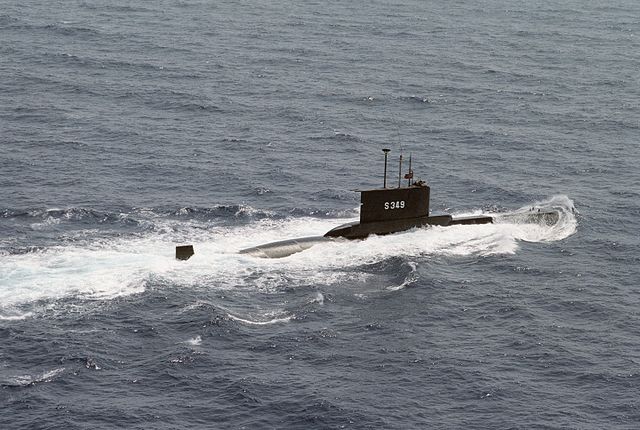
This class marked a turning point for the Turkey submarine fleet. These were essentially six German-designed Type 209 conventional attack submarines, single-hull medium size, capable of diving to 650 feets of 200 m. Twelve were initially planned, the first three in Germany at Howaldstwerke in Kiel and the remainder in Turkey at gölcük. However these Type 209/1200 were only partially completed: The serie was stopped after the thord Turkish-built boat, Dolunay, built in 1983-89 to swap on the larger and more promising Type 209/1400. The first two had a Dutch Hollandse Signaal M8 torpedo fire control, and the last four the HSA SINBADS. All but two are still extant. TCG Atilay was decommissioned in 2016 and Saldilay in 2018 (est.)
—-Amphibious warfare—-
Turkish LSTs (1972-85)
Bayraktar class: sister ship Sancartar, ex-US LST-511 type transferred to W Germany 1961 (minelayers), retransferred 1972, conv. back as LSTs. In service 1990s.
Etrugul class: sister ship Serdar, e-Terrebone parrish class ships transferred 1973, extant 1990s
Cakabey class: sister ship Karamurselbey: Built at Taskizak NyD Istanbul, launched 1977. 2600 tonnes, 92x 14 x2.3m, 3 shafts diesels 4320 hp 14 knots. Armed with three 10 mm Bofos, 4x 20 mm Oerlikon, 150 mines. Can carry 12 trucks, 600 troops and two LCVPs aft and two stern minelayer ports.
Osman Gazi class: Built in the same yard, Osman Gazi and Orhan Gazi had 50% greater capacity lift than the earlier Sarucabey. Launched 1994, see the modern navy section.
Turkish Landing Crafts
-Five ex-British LCT(4) types, 700 tonnes: C101-C106, BU 1981-85.
-Thirty-one EDIC types, 600 tonnes. Transferred, one lost, other stricken, remainder extant 1990.
-Four LCU-501 class, 320 tonnes. Transferred 1967, stricken 1986.
-Eleven Turkish-built LCU 205 type, 405 tonnes built 1965-66, stricken 1990s
-Thirty Turkish-built LCU 301 type, 113 tonnes built 1965, stricken 1990s (still 22 in 1995).
-Sixteen Turkish-built LCU 139 type, 600 tonnes built 1984-93. Still partly in service. Carried 6 tanks and 600 troops.
—-Small surface combatants—-
Fast Attack Crafts
Dogan class: Dogan and Marti were ex-Norwegian british built Nasty type FACs, Tjeld class, transferred 1959-60 and discarded in the 1970s
Firtina class: firtina, Tufan, Kilic, mizrak, Yildiz, Kalkan, Karayel, of the West German Jaguar type FAC. Transferred in late 1975 and 1976. Ex Fuchs and Reier were transferred for spare parts. Discarded in the 1990s.
Kartal class: Denizkusu, Atmaca, Sain, Kartal, Melten, Pelikan, Albatros, Simsek, Kasirga. convertible FAC/PBs by Lürssen for Turkey 1967-71. Four were fitted with SSM instead of their TTs and five more upgraded later. Melten sunk in collision with a soviet ship 1985. The remainder extant in the 1990s.
Dogan (ii) class: Modern missile FACs based on Lürssen FPB 57 design, delivered 1977-95. Serie I: Dogan, Marti, Tayfun, Volkam, Ruzgar, Poyram, Gayret, Firtina 1975-88
Serie II 1994: Yildiz, Karayel and three more (Specs to come).
Patrol Boats
Candarli class: Eight ex-US AUK types acquired in 1947. Stricken 1963 to 1986.
Alanya class: Four ex-UK Bathurst class types acquired 1946. Discarded 1963-75.
Bafra class: Ten ex-UK Bangor class types acquired 1957. Discarded in the early 1970s.
Sultanishar class: Six ex US PC types acquired 1963. Kochisar was built at Gölcük NyD.
AB-21 class: Four ex-US PGM class transferred 1967.
Yildrim class: Two ex US Asheville class, transferred 1973. Yildrim exploded and sank off Lesbos 1985.
TCG Girne: Single vessel built at Taskizak NyD Istanbul in 1975, comp. 1976. Design based on Lürssen based on the Spanish variant Lazaga with a lighter armament.
LS9 class: Ten ex-US 83ft patrol coast guard cutters built for Turkey in 1953. Extant in the 1990s.
AB25 class: Eleven 150 tonnes PBs built with French assistance in 1967-70 as Taskizak NyD. 150/170 tonnes, 40.2 x 6.4 x 1.7m, 2 shafts diesel 4800 shp 22 kts, armed with 2 x 40 mm AA or 1x 40/1x 20, and some has a mousetrap ASW launcher and DC racks. In 1991 pennants became P125-136.
—-Mine warfare vessels—-
-Nusret
-Mordogan class
-Samsun class
-Trabzon class
-Karamürsel class
-Kas class
-Foca class
—-Miscellaneous ships—-
-Gezayirli class support ships
Post-cold war Turkish Navy
Tepe class Frigates (1993)
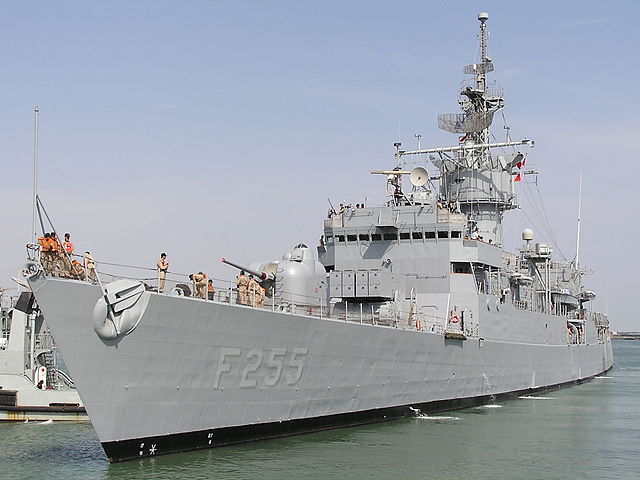
Eight units of the Knox class, transferred on lease at first, then acquired. Named Muavenet, Adatepe, Kocatepe, Zafer, Ege, Karadeniz, Akdeniz, Trakya. Identical modernize ships has been transferred to Greece, Egypt and Taiwan. The Turkish ones were equipped with Harpoon missiles with a modified ASROC to fire them. However they don’t have a towed array sonar. The Turkish admiralty somewhat resisted to the acquisition of these ships, they estimated lightly armed and in poor conditions. Acquired in 1993-94, thy were all decommissioned in the 2000s, the last in 2011.
Barbaros (“Reis”) class Frigates (1994)
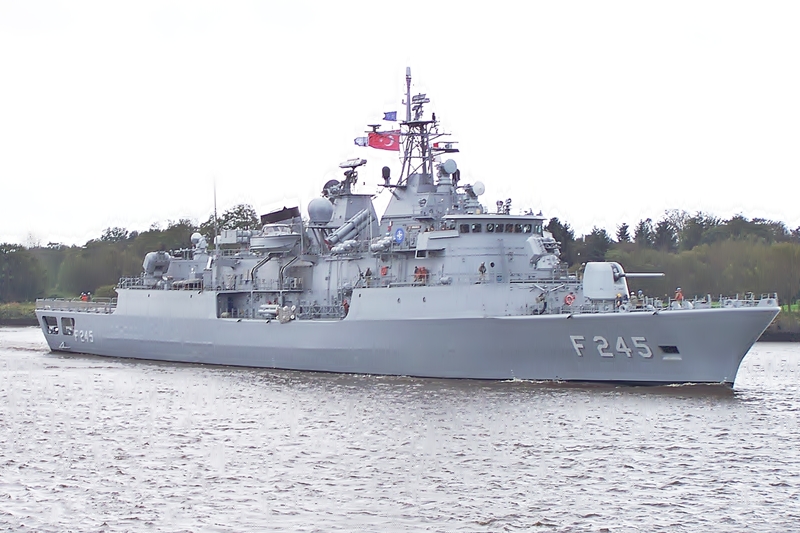
Lenghtened versions of the MEKO 200 class, first ordered in January 1990, and second pair in 1992. Named Barabos, Oruc Reis, Salihreis and Kemalreis they were partly built at Blohm & Voss and GölKük. CODOG propulsion improved electroncs and better NBC protection. They were the first to use a 16-cell Sea Sparrow VLS SAM system. The armament however was the same as the Yavuz class.
On 3 April 2018 a contract was signed between ASELSAN/HAVELSAN as a Joint Venture and the secretariat for Defense Industry for their mid-life modernization project with two 8-cell Mk41 vertical launcher system (VLS) replacing the MK29 Sea Sparrow while the AWS-9 3D air search radars were replaced by the Thales SMART-S Mk2 3D radars.
Gabya class Frigates (1997)
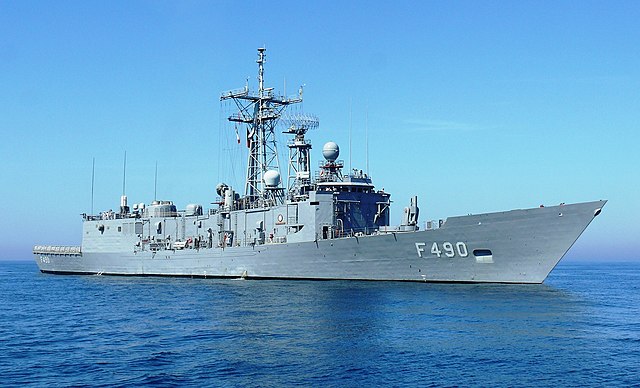
This numerically important class was acquired from the US, in part to compensate for the earlier Knox class: They were nine modernized OH Perry ships, named TCG Gaziantep, Giresun, Gemlik, Gelibolu, Gökçeada, Gediz, Gökova, and Göksu. They were heavily modernized ships, with the GENESIS advanced combat management system, 8-cell Mk-41 VLS (Evolved Sea Sparrow) long-range radar and sonar systems.
Burak class Corvettes (1999)
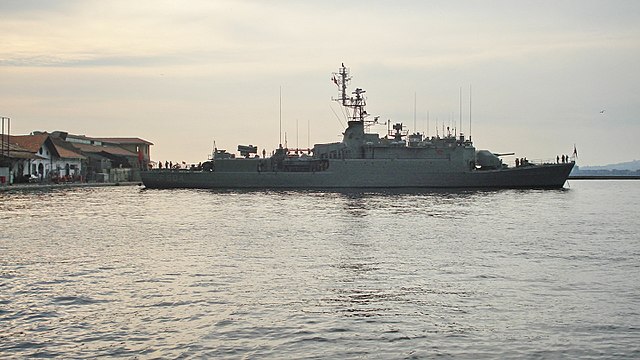
These ex-Estienne d’Orves corvettes decommissioned, were sold to Turkey: Also called “B class” they were intended as a stopgap before the Ada class Frigates were completed. The class comprised TCG Bozcaada, Bodrum, Bandırma, Beykoz, Bartın and Bafra. These 1300 tonnes vessels transferred in 1999-2002 received an electro-optical modernization. They are used for coastal anti-submarine defense, ocean escort missions and economical propulsion system for overseas operations.
Preveze class submarines (1993)
Preveze, Sakarya, Mart, Anarfartalar
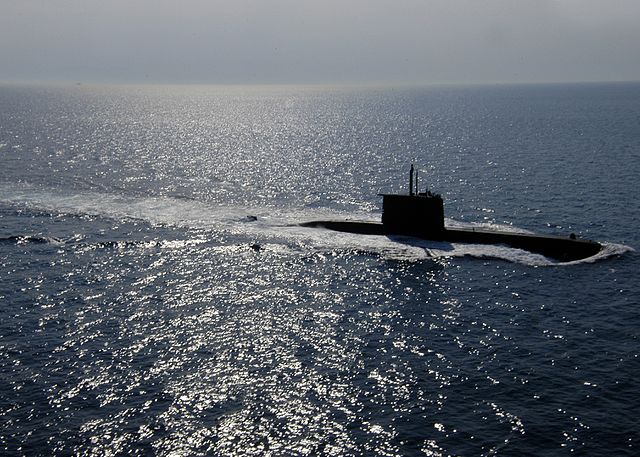
TCG Preveze during exercise Sorbet Royal 2005
Type 209/1400 built in Turkey, at Gölcük NyD. The local desigfn diverged from the standard German 209/1400. The first pair was ordered in 1987, the second in 1994. They could dive at 1050 feets or 320 m and their torpedo tubes are able to launch the sub-harpoon and lay mines.
Specifications:
Gür class submarines (2002)
TCG Gür, Çanakkale, Burakreis, I. İnönü
Improved versions of the former called T2/1400, also built in Gölcük.
Reis class submarines (2020)
TCG Pirireis, Hızırreis, Muratreis, Aydınreis, Seydialireis, Selmanreisr
currently building, local variant of the German Type 214 said to be the world’s most silent conventional attack submarine class. So far only TCG Piri raid has been launched, on 22 December 2019, completion is expected in fall 2020 to mid-2021 and the rest until 2026.
Kılıç-class fast attack craft (1997)
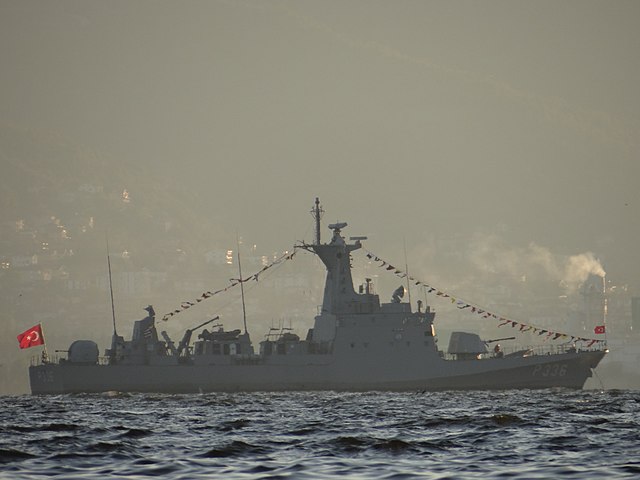
Designed as light corvettes by Lürssen Werft, with a specially developed superstructure/mast for low radar cross-section. Top speed 24 knots (44 km/h) in Sea State 5. First batch of 3 designated Kılıç I class, second batch of 6 Kılıç II, built in Turkey. They recently received a local SATCOM. Class: Kılıç, Kalkan, Mızrak, Tufan, Meltem, İmbat, Zıpkın, Atak, Bora.


 Latest Facebook Entry -
Latest Facebook Entry -  X(Tweeter) Naval Encyclopedia's deck archive
X(Tweeter) Naval Encyclopedia's deck archive Instagram (@navalencyc)
Instagram (@navalencyc)





 Austrian Navy
Austrian Navy French Navy
French Navy Royal Navy
Royal Navy Armada Espanola
Armada Espanola K.u.K. Kriegsmarine
K.u.K. Kriegsmarine Dansk Marine
Dansk Marine Nautiko Hellenon
Nautiko Hellenon Koninklije Marine 1870
Koninklije Marine 1870 Marinha do Brasil
Marinha do Brasil Osmanlı Donanması
Osmanlı Donanması Marina Do Peru
Marina Do Peru Marinha do Portugal
Marinha do Portugal Regia Marina 1870
Regia Marina 1870 Nihhon Kaigun 1870
Nihhon Kaigun 1870 Preußische Marine 1870
Preußische Marine 1870 Russkiy Flot 1870
Russkiy Flot 1870 Svenska marinen
Svenska marinen Søværnet
Søværnet Union Navy
Union Navy Confederate Navy
Confederate Navy Armada de Argentina
Armada de Argentina Imperial Chinese Navy
Imperial Chinese Navy Marinha do Portugal
Marinha do Portugal Mexico
Mexico Kaiserliche Marine
Kaiserliche Marine 1898 US Navy
1898 US Navy Russkiy Flot
Russkiy Flot French Naval Aviation
French Naval Aviation Russian Naval Aviation
Russian Naval Aviation Sovietskiy Flot
Sovietskiy Flot Royal Canadian Navy
Royal Canadian Navy Royal Australian Navy
Royal Australian Navy RNZN Fleet
RNZN Fleet Chinese Navy 1937
Chinese Navy 1937 Kriegsmarine
Kriegsmarine Chilean Navy
Chilean Navy Danish Navy
Danish Navy Finnish Navy
Finnish Navy Hellenic Navy
Hellenic Navy Polish Navy
Polish Navy Romanian Navy
Romanian Navy Turkish Navy
Turkish Navy Royal Yugoslav Navy
Royal Yugoslav Navy Royal Thai Navy
Royal Thai Navy Minor Navies
Minor Navies Albania
Albania Austria
Austria Belgium
Belgium Columbia
Columbia Costa Rica
Costa Rica Cuba
Cuba Czechoslovakia
Czechoslovakia Dominican Republic
Dominican Republic Haiti
Haiti Hungary
Hungary Honduras
Honduras Estonia
Estonia Iceland
Iceland Eire
Eire Equador
Equador Iran
Iran Iraq
Iraq Latvia
Latvia Liberia
Liberia Lithuania
Lithuania Mandchukuo
Mandchukuo Morocco
Morocco Nicaragua
Nicaragua Persia
Persia San Salvador
San Salvador Sarawak
Sarawak Uruguay
Uruguay Venezuela
Venezuela Zanzibar
Zanzibar Warsaw Pact Navies
Warsaw Pact Navies Bulgaria
Bulgaria Hungary
Hungary

 Bundesmarine
Bundesmarine Dutch Navy
Dutch Navy Hellenic Navy
Hellenic Navy Marina Militare
Marina Militare Taiwanese Navy
Taiwanese Navy Chinese Navy
Chinese Navy Indian Navy
Indian Navy Indonesian Navy
Indonesian Navy JMSDF
JMSDF North Korean Navy
North Korean Navy Philippines Navy
Philippines Navy ROKN
ROKN IDF Navy
IDF Navy Royal New Zealand Navy
Royal New Zealand Navy Egyptian Navy
Egyptian Navy South African Navy
South African Navy

































 RN
RN
 Marine Nationale
Marine Nationale
 Soviet Navy
Soviet Navy
 dbodesign
dbodesign